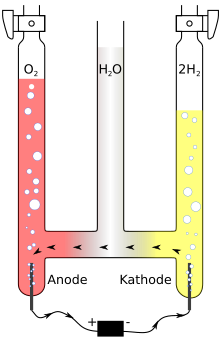Hofmann's water decomposition apparatus
The Hofmann water decomposition apparatus , Hofmann decomposition apparatus or water decomposition apparatus according to Hofmann is a device for the electrolytic decomposition of aqueous solutions and was named after August Wilhelm Hofmann (1818-1892) who developed this experimental setup for example. B. in his book published in 1866. The experimental set-up was also used as a voltameter .
function
It is used to demonstrate the electrolytic decomposition of water, for example . In this case, the entire apparatus is usually filled with dilute sulfuric acid , since pure water does not have sufficient electrical conductivity. After applying a DC voltage to the platinum electrodes or carbon electrodes , gas is generated at the cathode and anode .
The water is broken down into its two components, oxygen and hydrogen . The resulting gases collect in the two measuring tubes and can be removed with the help of a tap. At the cathode, the oxonium ions , which were created by protolysis of the added acid, are reduced to hydrogen and the water is oxidized to oxygen and oxonium ions at the anode .
Cathode reaction:
Anode reaction:
Overall reaction:
The ratio of the gas volumes in the legs will be 1: 2 (oxygen: hydrogen). However, this relationship cannot exactly come about, as oxygen dissolves better in water than hydrogen at the beginning. To avoid this problem, the experiment should run a few minutes beforehand with the taps open.
functionality
The positively charged oxonium ions, which are in the vicinity of the negatively charged electrode, the cathode, are attracted by the negative charge and discharged there, releasing hydrogen (cathodic reduction). In the area of the positively charged electrode, the anode, electrons are withdrawn from the water (anodic oxidation). The oxidized water particles are unstable and disintegrate, releasing oxygen and forming oxonium ions. The oxonium ions do not have to migrate through the solution to the cathode; rather, they pass on their positive charge via a reorientation of the hydrogen bonds through the solution to the cathode:
This form of electrical conduction is called proton conduction and is described by the Grotthus mechanism .
See also
literature
- Entry on Hofmann's decomposition apparatus. In: Römpp Online . Georg Thieme Verlag, accessed on June 21, 2014.
Web links
- Hofmann's decomposition apparatus ( Memento from November 12, 2011 in the Internet Archive ) (PDF file; 30 kB)
Individual evidence
- ^ August Wilhelm Hofmann: Introduction to modern chemistry: experimental and theoretic; embodying ... Walton and Maberly, 1866, p. 55 ( limited preview in Google Book search).
- ↑ Peter Kurzweil: Chemistry . Springer Vieweg, Wiesbaden 2015, ISBN 978-3-658-08660-2 , p. 198 , doi : 10.1007 / 978-3-658-08660-2 .
- ↑ Script of the Helmholtz Society's Quantum Leap School Laboratory: Hydrogen and Fuel Cell (PDF; 8.3 MB).




